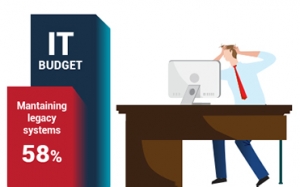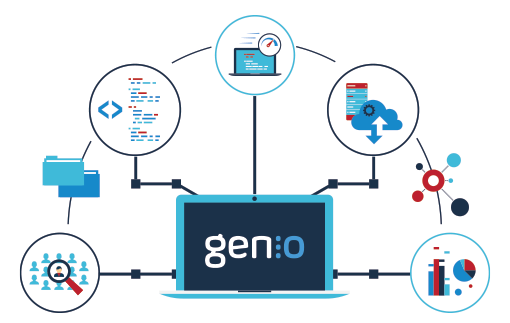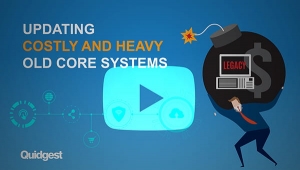Defusing the legacy bomb
João Simões Abreu, March 05, 2021
The business world requires software more than ever. The COVID-19 pandemic brought a shining light to the importance digital channels have on numerous business models. Companies in which plans to adopt digital mediums were never on the table had to implement them quickly – this either enabled them to survive or thrive during these turbulent times.
“Every business is a software business”
Said Watts Humphrey, software engineering pioneer and dubbed the “father of software quality”, nearly 20 years ago. Regrettably, only recently, decision-makers from various fields realized this. The rush to embrace digital channels without proper planning or strategy might have cut short its impact on businesses. But more than operating systems, companies need modern and agile core systems – the ones that allow them to swiftly pivot their strategy and make technology capabilities not a barrier but an enabler for transformation, and to quickly launch new products and services as well as comply with the new regulation.
The reality among big corporations is the technology used is often outdated. Organizations that were once earlyadopters on enabling tech on their operations are now using legacy systems to control their businesses.
WHAT IS A LEGACY SYSTEM?
According to Gartner, a legacy system is an information system that may be based on outdated technologies but is critical to day-to-day operations. Replacing legacy applications and systems with systems based on new and different technologies is one of the information systems professional’s most significant challenges.
The legacy trouble
The existing large software systems were never built to cope with the current business requirements and its natural evolution, one of the challenging issues in today’s competitive environment. These computer programs are not flexible enough to continually evolve and eventually undermine companies’ growth strategies.
To compete side-by-side with the top industry performers and attract and retain customers, leaders must adopt platforms that enable rapid innovation for their digital business initiatives. Otherwise, more agile competitors will launch products and services and devour incumbents’ market share.
Modern applications that can potentially disrupt and grow businesses require new technologies and architectures such as cloud, mobile, in-memory computing, web-scale, microservices, hybrid IT, and Application Programming Interfaces. This, by itself, is a challenge to traditional and legacy systems that do not support or run cloud-native applications, for example. Moreover, business leaders who intend to keep their legacy systems up and running will face barriers that will only rise as the years pass.
The following three are just the tip of the iceberg of an endless list of problems companies are bound to face when sticking to legacy systems.
1. Skilled human resources
Skilled human resources who can work with obsolete platforms will only get harder and harder to hire. Most of the programming languages used in legacy systems are outdated, so much that university students are not taught how to operate them. Consequently, companies working with obsolete systems often have to rely on the few skilled human resources who can navigate their way in these ancient computer programs. This is a problem for two main reasons: they will not be able to bring new and fresh-minded programmers to work for them, and the skilled programmers that can operate the system will only get more and more expensive.
2. The absence of up-to-date documentation
The absence of up-to-date documentation makes the problem mentioned above even harder. Newcomers who joined the IT force will have to rely on the team members who already know how to cope with the system.
3. Lack of integration
Lack of integration is also a big part of the legacy challenge. The absence of interfaces and integration services carries a great difficulty to integrate with other systems. In turn, this means companies who want to innovate will most likely not be able to so.
All in all, this adds up to costly maintenance of legacy system software since fault detection is expensive and time-consuming – due to improper documentation and consequent lack of knowledge about functionalities of the system (also the reason why these kinds of systems are standing still most of the time).
According to Cybera, the average retailer spends 58% of the IT budget on maintaining legacy systems. And although the largest percentage of the budget goes to maintaining it, the system’s evolution to provide new functionalities is nearly impossible, leaving little to no room for other innovative projects in the pipeline.

A natural evolution?
An Avanade study indicates that 80% of senior IT decision-makers believe that not modernizing IT systems will negatively impact their organization’s long-term growth. Around two-thirds note that conventional systems and approaches typically used are not fit for solving digital businesses’ emerging requirements.
On the opposite side of the spectrum, they also consider the modernization of core systems has the potential to boost annual revenue by over 14%.
Additionally, business operating costs can benefit as well: respondents anticipate that business operating costs can be reduced by 13% with updated core systems. Nine in ten believe modern software engineering approaches and process automation technologies are vital to addressing emerging digital business requirements.
With all this in mind, why are companies stuck to systems that not only are costly but are also dragging them behind their competition?
They may be unaware. Leaders can be behind without acknowledging it, which is the worst-case scenario since dramatic changes to their businesses can happen unexpectedly. It can also occur that previous systems implementations took so long decisionmakers are afraid the next update will also be interminable. Furthermore, there are often fears that prevent people from migrating to another platform. Data loss when migrating, high costs involved in the transition, and the lack of flexibility of the new system are among the mental barriers business leaders face when deciding on sticking to the same platform or updating it.






